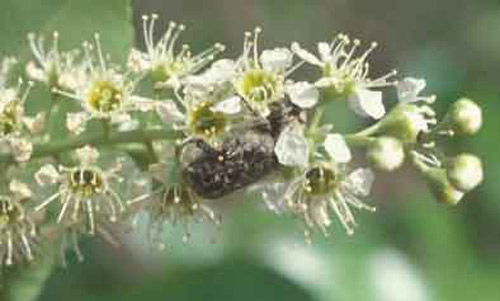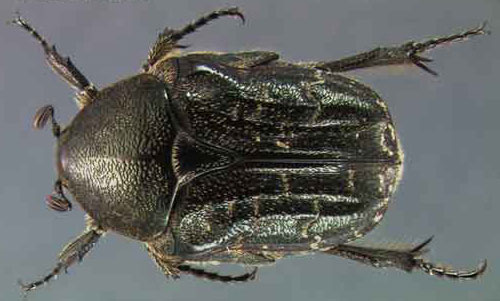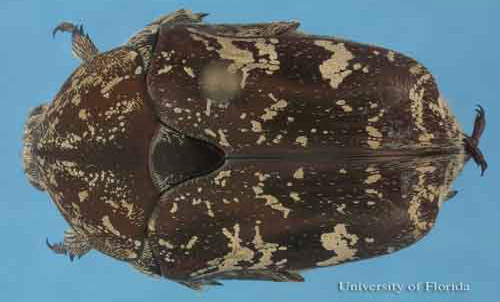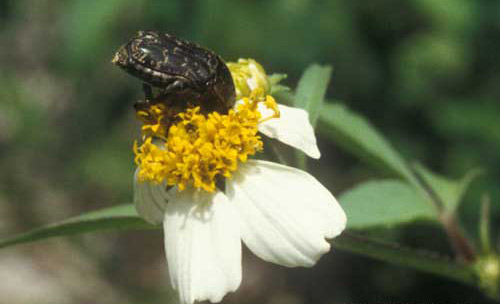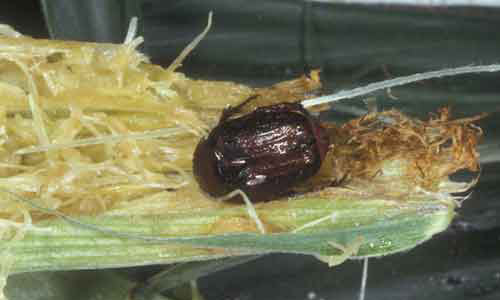common name: a flower beetle
scientific name: Euphoria sepulcralis (Fabricius) (Insecta: Coleoptera: Scarabaeidae)
Introduction - Synonymy - Distribution - Identification - Biology - Hosts - Pest Status - Selected References
Introduction (Back to Top)
Euphoria sepulcralis (Fabricius) is a common, day-flying scarab beetle in Florida and much of the eastern half of the United States, and one of the beetles most frequently submitted to the Division of Plant Industry (DPI) Entomology Section for identification. Occasionally, it achieves pest status because of the damage it does to corn, roses, and the flowers of blooming fruit trees.
Figure 1. Adult Euphoria sepulcralis (Fabricius), a flower beetle, feeding on black cherry. Photograph by Lyle J. Buss, University of Florida.
Synonymy (Back to Top)
Although the spelling sepulchralis occurs in nearly all literature, Ratcliffe (1991) noted that the spelling in the original description (Fabricius 1801) is sepulcralis. Casey (1915) described a number of subspecies, which are not considered here.
Distribution (Back to Top)
Euphoria sepulcralis is found throughout the eastern U.S. as far north as Illinois and Indiana and west to Texas (Ritcher 1945, Ratcliffe 1991). There are also specimens in the Florida State Collection of Arthropods (FSCA) from Nassau, Bahamas. It occurs everywhere in Florida, from Escambia County in the western Panhandle to Key West in Monroe County. DPI records and FSCA specimens represent 189 localities in 52 of Florida's 67 counties.
Identification (Back to Top)
This species is one of seven in four genera of the scarab subfamily Cetoniinae known from Florida in which the mesepimera are visible from above between the pronotum and elytral humeri and the mandibles are small and mostly membranous. Of these, only E. seputeralis and Protaetia fusca (Herbst) are dark with white or cream markings. Protaetia fusca is an immigrant from the Orient, and is now found in Florida in Dade, Broward, and Palm Beach counties.
Euphoria sepulcralis is 10 mm to 14 mm long, dark brown to black, with metallic bronze or green reflections. Dorsally, it is heavily punctate, with the surface between punctures smooth and shining. The elytra are slightly dentate at the sutural angle and are ornamented with white cretaceous spots, arranged more or less transversely.
Figure 2. Adult Euphoria sepulcralis (Fabricius), a flower beetle. Photograph by Shawron Weingarten, University of Florida.
Protaetia fusca is an Asian species established in southeastern Florida. It is sparsely punctate with the surface between punctures dull, the cretaceous spots are present on the elytra and pronotum, and the sutural angle is usually strongly spinose.
Figure 3. Adult Protaetia fusca (Herbst), a flower beetle. Photograph by Lyle J. Buss, University of Florida.
Biology (Back to Top)
Little is known about the biology of this species, especially of the immature stages. Larvae have been found in soil beneath dead sod or manure (Ritcher 1945). The length of the larval stage averaged 62.7 days and of the pupal stage 15.4 days (Hayes 1925). Pupation is in an earthen cell (Ratcliff 1991).
In Kentucky, Ritcher (1945) reported the beetles have a one-year life cycle with pupation occurring in August and adults flying from August to October and again in the spring. In Florida, adults have been collected in all months except October and December, with peak summer abundance in August, at least in Alachua County (Landolt 1990). Adults are found on flowers, where they apparently are pollen feeders, at fermenting sap flows, and on ripe or decaying fruit. Landolt (1990) found that adults are attracted to isopropyl (rubbing) alcohol and Cherry and Klein (1992) showed they are attracted to various aromatic compounds used in Japanese beetle (Popillia japonica Newman) traps.
Hosts (Back to Top)
Ratcliffe (1991) noted: "The adults feed on tree sap, a wide variety of ripening fruits, corn, and the flowers of apple, thistle, mock orange, milkweed, dogwood, sumac, yarrow, daisies, and goldenrod."
Plant associations from DPI records and FSCA specimens are:
Acalypha sp., Acer rubrum L. (foliage), Adonidia sp., Alcea rosea L., Allamanda sp., Ambrosia artemisiifolia L., Ambrosia sp., Anethum sp., Aronia arbutifolia (L.) Pers., Asimina reticulata Chapm., Asimina triloba (L.) Dunal, Asystasia gangetica (L.) T. Anders., Averrhoa carambola L.,
Baccharis angustifolia Michx., Bidens bipinnata L., Bidens sp., Bombax sp., Borreria sp., Brassica juncea (L.) Czerniak, Brassica oleracea L., Bucida buceras L., Bursera simaruba (L.) Sarg.,
Figure 4. Adult Euphoria sepulcralis (Fabricius), a flower beetle, feeding on Bidens sp. Photograph by Lyle J. Buss, University of Florida.
Callistemon viminalis (Sol. ex Gaertn.) G. Don ex Loud., Capsicum annuum L., Capsicum annuum L., Grossum group, Carya illinoensis (Wangenh.) Koch, Castanea mollissima Blume, Cattleya sp., Cenchrus sp., Ceratiola ericoides Michx., Cereus sp. (fruit), Cirsium vulgare Savi (Ten), Cirsium sp., Citrus aurantifolia (Christm.) Swingle, Citrus limon (L.) Burm. f., X Citrofortunella microcarpa (Bunge) Wijnands, Citrus reticulata Blanco, Citrus x paradisi (L.) Macf., Coccoloba uvifera (L.) L., Cocos nucifera L. (in fermenting wound), Colvillea racemosa Bojer ex Hook., Cornus sp., Cortaderia selloana (Schutt and Schutt. f.) Asch. and Gräbn., Crataegus sp., Crinum americanum L., Crotalaria sp., Cyrilla racemiflora L.,
Dahlia sp., Dendranthema x grandiflorum Kitam, Dendrobium sp., Desmodium tortuosum (Sw.) DC., Diospyros sp.,
Erigeron quercifolius Lam., Eupatorium capillifolium (Lam.) Small, Euphorbia pulcherrima Willd. ex Klotzsch.,
Ficus benjamina L., Ficus carica L. (fruit), Ficus retusa L., Foeniculum vulgare Mill., Fortunella margarita (Lour.) Swingle, Fraxinus caroliniana Mill.,
Ginkgo biloba L. (stern),
Helianthus sp., Hibiscus elatus Sw., Abelmoschus esculentus (L.) Moench., Hibiscus rosa-sinensis L., Hypericum fasciculatum Lam.,
Ipomoea batatas (L.) Lam.,
Lagerstroemia indica L., Lantana sp., Ligustrum japonicum Thunb., Ligustrum lucidum Ait. f., Ligustrum sinense Lour., Litchi chinensis Sonn., Lobularia maritima (L.) Desv., Ludwigia sp., Lycopersicon esculentum Mill (fruit),
Magnolia sp., Malus sp. (decaying fruit), Mangifera indica L., Musa sp.,
Opuntia sp.,
Persea americana Mill., Phaseolus lunatus L., Philodendron sp., Phoenix canariensis Hort. ex Chabaud., Pimpinella anisum L., Pinus clausa (Chapm. ex Engelm.) Vasey ex Sarg., Pinus elliottii Engelm., Polyscias guilfoylei (Bull) L.H. Bailey ‘Victoriae', Pritchardia sp., Prunus persica (L.) Batsch., Pseudogynoxys chenopodioides (Kunth) Cabr., Psidium guajava L., Pyracantha coccinea Roem., Pyrus communis L.,
Quercus laevis Walt., Quercus laurifolia Michx.,
Rhus copallina L., Rhus glabra L., Rosa sp., Rubus sp.,
Sabal palmetto Lodd., Schefflera actinophylla (Endl.) Harms, Schefflera arboricola (Hayata) Merr. (foliage), Schinus terebinthifolius Raddi, Serenoa repens (Bartr.) Small, Simarouba glauca DC., Solanum melongena L., Spermacoce verticillata L., Stokesia sp.,
Tagetes erecta L., Terminalia catappa L.,
Veitchii merrillii (Becc.) H.E. Moore, Viburnum odoratissimum Ker.-Gawl., Vitis sp.,
Yucca sp.,
Zea mays L., Zigadenus densus (Desr.) Fern.,
plus eating honey in bee hive, in bromeliad, in millet, in orchids.
Pest Status (Back to Top)
Euphoria sepulcralis has been recorded as a pest of corn (Ritcher 1945, Ratcliffe 1991) and roses (Spencer and Jarratt 1989). DPI records for Florida include many for those hosts, with annotations such as "10-15 beetles per ear of corn." Records also suggest it can be a pest of mango and avocado in South Florida, where large numbers of the beetles destroy the flowers and thus reduce the number of fruits produced. There are also records of the beetles invading bee hives and damaging combs.
Figure 5. Adult Euphoria sepulcralis (Fabricius), a flower beetle, feeding on corn. Photograph by Lyle J. Buss, University of Florida.
Acknowledgments (Back to Top)
I thank Brenda Beck for helping to compile locality and host records, and DPI botanist Dr. Nancy Coile for checking plant names.
Selected References (Back to Top)
- Casey TL. 1915. A review of the American species of Rutelinae, Dynastinae and Cetoniinae. Memoirs on the Coleoptera 6: 1-394.
- Cherry RH, Klein MG. 1992. Attraction of adult Euphoria sepulchralis (Coleoptera: Scarabaeidae) to aromatic compounds. Florida Entomologist 75: 383-385.
- Fabricius J. 1801. Systema eleutheratorum, Vol. 2. Kiliae, 687 p.
- Hayes WP. 1925. A comparative study of the life-cycle of certain phytophagous scarabaeid beetles. Kansas Agricultural Experiment Station Technical Bulletin 16: 1-146.
- Landolt PJ. 1990. Trapping the green June beetle (Coleoptera: Scarabaeidae) with isopropanol. Florida Entomologist 73: 328-330.
- Ratcliffe BC. 1991. The scarab beetles of Nebraska. Bulletin of the University of Nebraska State Museum 12: 1-333.
- Ritcher PO. 1945. North American Cetoniinae with descriptions of larvae and keys to genera and species (Coleoptera: Scarabaeidae). Kentucky Agricultural Experiment Station Bulletin 476: 1-39.
- Spencer JA, Jarratt JH. 1989. Euphoria sepulchralis (Coleoptera: Scarabaeidae) damage to rose (Rosa) flowers in Mississippi. Journal of Entomological Science 24: 7-8.
